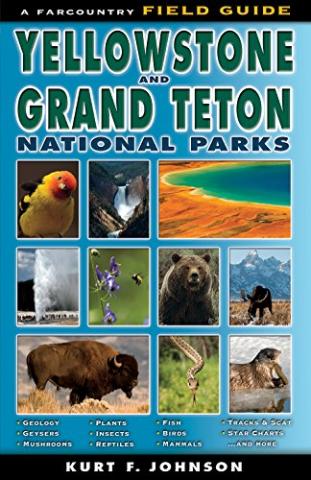How many times have you found yourself in a national park gazing at an animal track, a tree, or perhaps just an insect, and wondered what exactly you were looking at? Well, if your plans are taking you to Yellowstone or Grand Teton national parks, you might want to pick up a copy of The Field Guide To Yellowstone And Grand Teton National Parks.
This 244-page softcover book by Kurt F. Johnson will answer most, if not all, of your questions pertaining to the natural resources in those two parks. Though the cover features a grizzly staring at you, the guide covers much more than wildlife, with sections on geology, mushrooms, fish, tracks and scat, and even the stars overhead.
A biologist by training and guide for wildlife watchers in and around the two parks, Mr. Johnson doesn't fill this guide with page after page of narrative, but rather page after page after page of photos and illustrations of what you might encounter in the parks. You can see what Arrowleaf Balsamroot or Musk Thistle look like, as well as how to tell the poisonous Russula mushroom apart from the King Bolete, and even how to discern the difference between Bobcat tracks from Mountain Lion tracks.
With each entry, Mr. Johnson adds a few notes. In the case of the mushroom identification section, he lets you know which are poisonous and the distinguishing characteristics (such as the shape and color of the cap) and where they can be found. The tracking section, along with clearly showing the shape of an animal's track, also includes notes detailing the size of the track and length of stride.
Those in search of Yellowstone's thermal features will appreciate this section of the book, as the author provides maps of the individual thermal basins that clearly label where the various features are labeled. Those thermal feature names listed in bold are specifically described in the following pages, with details such as the height of a geyser cone, the water temperature, whether the waters are acidic, the depth of a hot spring.
Also mentioned, for Grand Teton fans, is Kelly Warm Springs, which is just east of the park along the Gros Ventre Road. Oddly, this field guide doesn't mention its location or provide a map to it. It does, however, note that the year-round water temperature of 70 degrees has made the spring ideal for some unusual, and non-native, critters, such as guppies and even Green swordtails that you would expect to see in an aquarium, not a hot/warm spring in Wyoming.
This field guide is rich in content, from geology to night skies to natural history, and will help you either prepare for your trip to Yellowstone or Grand Teton or help you answer puzzling questions that might arise during your visit.





Add comment